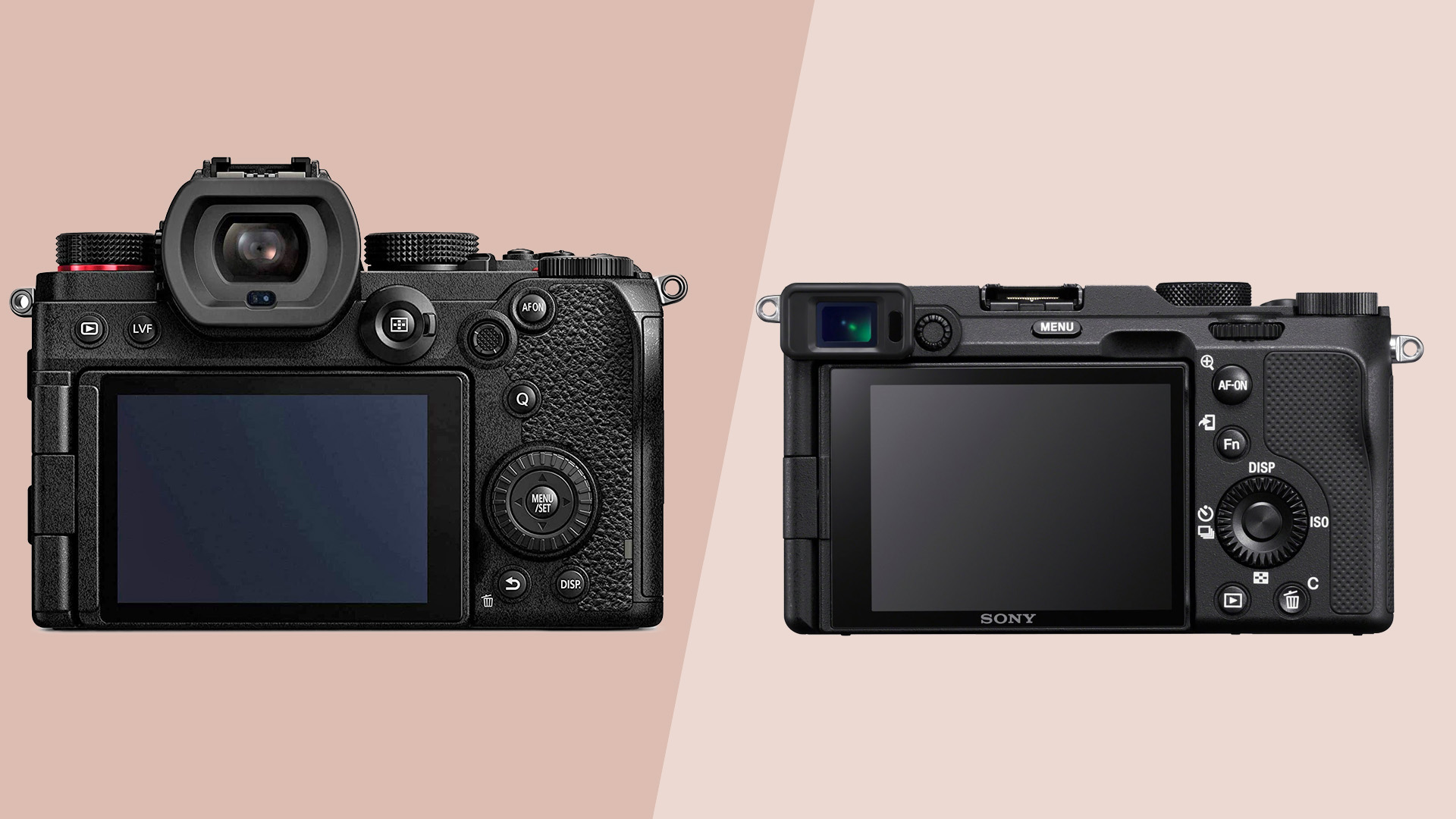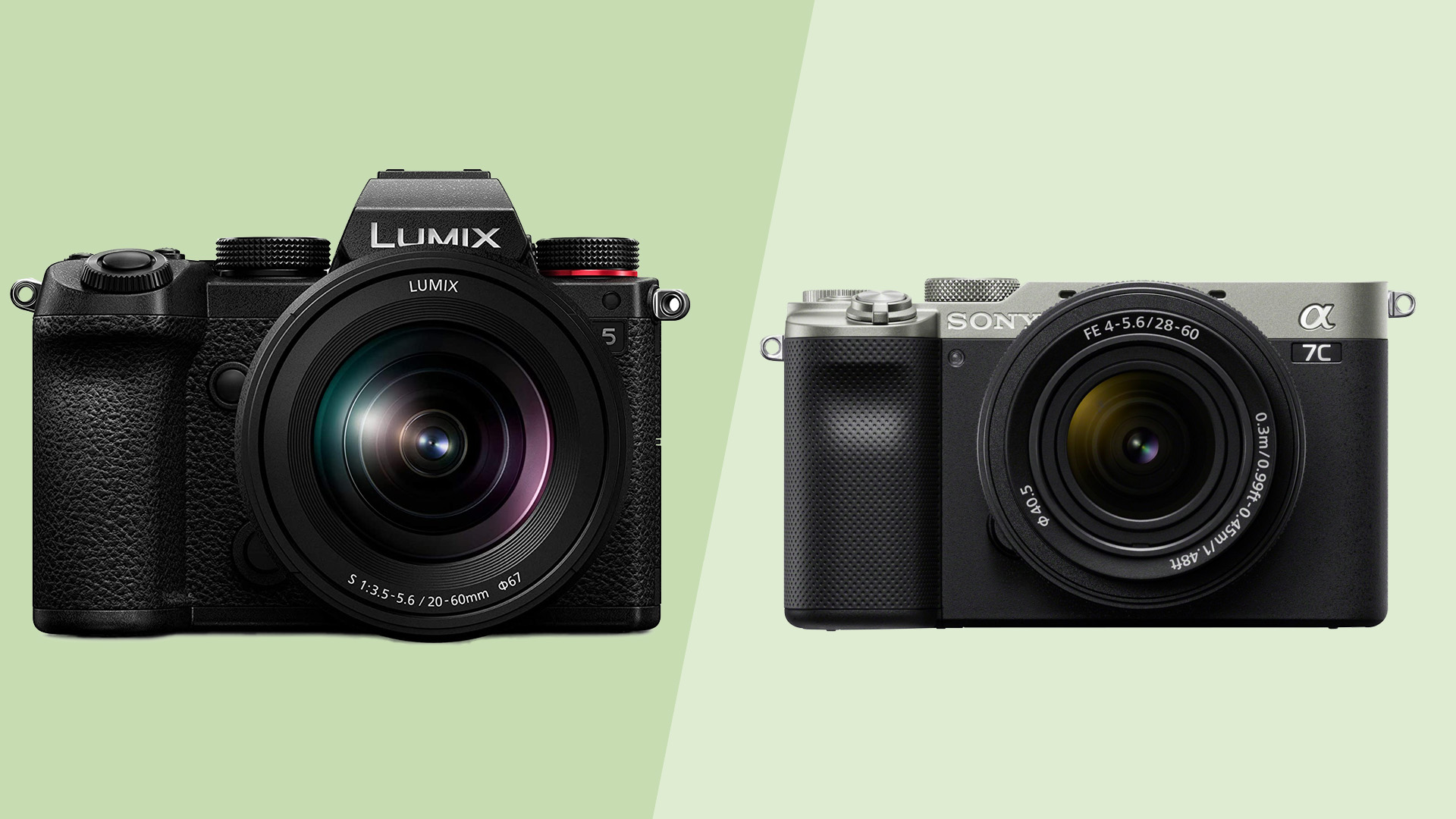One of the big camera trends of the year has been the arrival of small, affordable full-frame cameras. The Nikon Z5 landed in August, and now we've been treated to the Sony A7C and Panasonic Lumix S5.
While the Nikon Z5 is mainly aimed at stills shooters, the Sony A7C and Panasonic Lumix S5 are smaller and more video-oriented. Both are 24MP full-frame cameras that are the most compact models in their respective ranges, too.
Impressively, the Panasonic Lumix S5 is even smaller than the Panasonic Lumix GH5, which has a comparatively tiny Micro Four Thirds sensor, while the Sony A7C takes up less space than the Sony A7 III.
But which of these two cameras is better? The Sony has a faster burst mode and phase-detection autofocus, all packed into a smaller form factor than its rival.
The Panasonic Lumix S5, on the other hand, can shoot 4K/60p video and will, in the future, be able to send a 6K video feed to an external recorder.
On the surface, they're well-matched full-frame cameras, but dig a little deeper and you'll be able to find out which camera is really right for you...
- These are the best full-frame cameras you can buy right now
Sony A7C vs Panasonic Lumix S5: price and release date
The Panasonic Lumix S5 was announced shortly before the Sony A7C, with both cameras arriving in September 2020.
Their pricing is similar too, although the Lumix S5 is a little more affordable. Its body-only price is $1,999 / £1,799 / $3,199, with the 20-60mm f/3.5-5.6 kit lens bundle available for $2,299 / £1,999 / AU$3,699.
The Sony A7C, meanwhile, costs $1,800 / £1,900 / AU$3,299 body-only, or $2,100 / £2,150 / AU$3,899 with Sony’s new ultra-light FE 28-60mm f/4-5.6 lens. This lens will cost around $499 / £450 on its own, so it’s an even better investment than normal, as it's a lens more-or-less designed just for this body.
Sony A7C vs Panasonic Lumix S5: design
Both of these cameras are designed for portability and handheld shooting. They're also significantly smaller and lighter than some of their respective siblings. However, Sony has really nailed this part.
The Sony A7C has the same size sensor as the Panasonic Lumix S5, but is far more compact. At 124 x 71.1 x 59.7mm, this is the slightest full-frame Sony camera you can get. It is tiny, smaller in all dimensions than the 133 x 97 x 82mm Lumix S5.

Sony hasn’t altered the basic style of the body too much, as Alpha cameras are already fairly compact, but the A7C is still much trimmer than the 127 x 96 x 74mm Sony A7 III.
This means it will be best matched with the new ultra-light FE 28-60mm f/4-5.6 lens, and may seem a little out of place strapped onto one of the larger E-mount FE lenses. Much of the Alpha series’ grip has been chipped away to make the camera as small as it is.
When paired with its new kit lens, the Sony A7C weighs just 676g (509g body-only), where the Panasonic Lumix S5 body is 714g, rising above the kilo mark when you add its 20-60mm kit lens.
So while both of these cameras are relatively small and light, the Sony A7C is in another league.
While the engineers no doubt had to make some concessions for the downscaling in size, the Lumix S5 and Alpha A7C both have magnesium alloy inner shells and are water- and dust-resistant, too.
Sony A7C vs Panasonic Lumix S5: autofocus
Sony also has the upper hand for autofocus, at least on paper. The Lumix S5 continues to use Panasonic’s Depth from Defocus (DfD) tech, which is based on contrast detection. It simply adds some algorithmic image analysis to predict where the point of focus sits, to speed things up.
There are 225 points in the Panasonic Lumix S5’s focus system, just like on the Panasonic Lumix GH5.
The Sony Alpha A7C has both contrast detection and phase detection autofocus, with 693 phase-based points and 425 contrast ones. This system covers 93% of the field of view.

Panasonic has done a great job of bolstering the performance of contrast detection, to make it seem at least somewhat competitive in 2020. However, you may notice some mild focus pulsing at times as the Lumix S5 makes its final focus alterations. This is particularly important for video. The Sony A7C focus system is likely to feel more confident and decisive in use.
Despite this, Panasonic actually makes grander low-light focusing claims than Sony. It says the Lumix S5 can focus in environments as dark as -6EV, Sony -4EV.
This is something we’ll have to test first-hand, but both cameras do have essential software aids like eye tracking.
Why does Panasonic still use DfD? Hardware is no longer the obvious excuse, as plenty of full-frame sensors have the requisite on-sensor phase detection tech. The obvious reason is that Panasonic has worked on DfD for years, and currently thinks it is still the best fit for its cameras.
Sony A7C vs Panasonic Lumix S5: features
These cameras both have electronic viewfinders and fully articulated screens. They aren’t the kind of 'compact' mirrorless cameras of a few years ago where the essentials have been cut out to reduce size.
You get 3.5mm microphone and headphone jacks, USB-C charging and a dedicated movie button on each for quick and easy shooting.

The battery situation is the opposite of what you might expect, given their dimensions. Panasonic’s Lumix S5 is rated at 440 shots per charge (CIPA standard), compared to the Sony Alpha A7C's 680 shots (with the EVF) or 740 shots when using the display to compose.
This is partly thanks to Sony’s Z-series battery, which has a 2,280mAh capacity, although the stats of the Lumix S5 battery are actually very similar at 2,200mAh.
This means the Sony A7C is most likely a little easier on its battery than the Panasonic S5, although we'll need to conduct side-by-side tests to be sure.
Sony A7C vs Panasonic Lumix S5: video
Sony seems to have pushed the Alpha series further than Panasonic has done with the Lumix range so far, but there are some fundamental benefits to the Lumix S5.
It can shoot 4K video at up to 60 frames per second. By comparison, the Sony A7C only manages 4K at 30 frames per second. For some, that will be enough to tip things in Panasonic’s favor.
The Panasonic Lumix S5 can also record at 10-bit depth, better than the 8-bit of the Sony.
However, 4K at 60 frames uses an APS-C crop in the Lumix S5. To use the full-frame width you have to drop down to 30fps. The Sony A7C also uses this kind of oversampling to shoot at 4K without a crop.
What does this mean? The cameras’ 24MP sensors are actually too high-res to capture the entire frame without having too much data, or too many pixels, for a 4K image. They 'oversample' to bring it down to 4K resolution in the final file.
Recording time limits have become big news in camera circles recently, after many found the Canon EOS R5 overheats in around 15 minutes when shooting 8K video.
Sony says there’s “no recording time limit” in the Sony A7C. There is a 30-minute limit in the Panasonic Lumix S5, but only in the higher-end shooting modes that the Alpha lacks, using 10-bit 4K capture.

Even out their abilities and the stats are the same. Both cameras let you record continually at 8-bit 4K/30p. You’ll need a 30-degree-plus centigrade shooting day to really test this one out.
There’s a big upgrade coming to the Lumix S5, though. A (likely paid) firmware upgrade will let you record 6K video to an external recorder. At launch you can shoot 6K through a 30fps burst Photo mode, but this really isn’t the same.
The Lumix S5 is starting to look like the obvious choice for those who care more about video than stills.
The Panasonic Lumix S5 also offers slightly better slo-mo. It captures 1080p at up to 180fps, if at a limited bit-rate, with a crop. The Sony A7C, meanwhile, tops out at 120fps in 1080p.
Both cameras have flat S-Log/V-Log and HLG shooting modes, though, so any claims the Sony A7C isn’t a good choice for YouTubers and content creators are misplaced.
- Check out our guide to the best YouTube cameras you can buy right now
Sony A7C vs Panasonic Lumix S5: stills
Both cameras' 24MP full-frame sensors suggest that still image quality will be comparable. Expect between 14 and 15 stops of dynamic range at base ISO and very good low-light performance.
The Sony A7C and Panasonic Lumix S5’s ISO ranges are the same too: 100-51,200 native, which can be extended down to ISO 50 and up to ISO 204,800.
So, where’s the difference? Sony offers significantly better burst shooting. The Panasonic Lumix S5 manages 7fps, or 5fps with continuous autofocus. Sony’s camera is much faster, with 10fps using continuous autofocus. It’s very quick, and should make it a better fit for action photography.

One obvious question for stills shooters is whether Sony and Panasonic have had to water down their IBIS to make these cameras smaller. The A7C and Lumix S5 both have five-axis stabilization that will apparently give you five stops of stabilization. So there are no obvious cuts there.
The Panasonic’s system can be boosted to 6.5 stops with a stabilized lens. But the Sony A7C’s tiny kit lens does not have its own optical stabilization, which is no real surprise given its size.
Sony A7C vs Panasonic Lumix S5 early verdict
So what conclusions should we take from this head-to-head comparison? Map these differences onto a few scenarios and we get a clearer idea of who should buy the Sony A7C and Panasonic Lumix S5.
Do you shoot video in a fixed studio environment where the focus will be locked? The Lumix S5 is the obvious choice. You can shoot 4K at 60 frames per second, and will even have the option of 6K in the future if you can afford an external recorder.
The Sony A7C, meanwhile, probably makes more sense as a mixed-use hybrid camera, particularly if you want something small you can take everywhere. This thing is tiny given it has a full-frame sensor and IBIS.
We love the idea of taking it out with the new compact FE 28-60mm f/4-5.6 lens or the even smaller Sony 28mm f/2.8 pancake. It offers full-frame shooting, only in a body that's basically the same size as a compact APS-C camera like the Sony A6600. We'll bring you our full reviews of both cameras very soon.
- These are the best mirrorless cameras in the world right now
from TechRadar - All the latest technology news https://ift.tt/3mB7IQL
via IFTTT
Subscribe by Email
Follow Updates Articles from This Blog via Email


No Comments